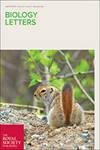Supersize me: hypotheses on torpor-assisted prehibernation fattening in a boreal bat.
IF 2.8
2区 生物学
Q2 BIOLOGY
引用次数: 0
Abstract
Hibernators face an energetic dilemma in the autumn at northern latitudes; while temperatures and food availability decrease, hibernating species need to build fat deposits to survive the winter. During this critical fattening phase, insectivorous boreal bats use torpor to build and conserve their reserves. However, we still know little about temporal variability in torpor use employed by bats during the prehibernation fattening period and how decreasing temperatures and food availability in combination with increasing individual body mass impact this. Here, we present two general hypotheses for explaining temporal torpor patterns observed in a boreal bat (Eptesicus nilssonii), in which torpor use (i) facilitates rapid mass gain or (ii) conserves stored body mass. Although temporally separated in our dataset, data on temperature, insect abundance and body mass throughout the prehibernation period indicate that E. nilssonii reaches the majority of its overwintering mass before the onset of increasing daytime and night-time torpor use. In combination with low food availability by this point in time, these observations suggest torpor expression may be intended to conserve gained reserves rather than facilitate mass gain. Our study is intended as a first proof of concept for disentangling temporal drivers of torpor in bats during the prehibernation fattening phase.超大的我:北方蝙蝠冬眠前增肥的假说。
在北纬地区,冬眠者在秋季面临着能量困境;当气温和食物供应减少时,冬眠的物种需要积累脂肪以度过冬天。在这一关键的增肥阶段,北方食虫蝙蝠利用冬眠来建立和保存它们的储备。然而,我们对蝙蝠在冬眠前的增肥期利用冬眠的时间变化,以及气温下降、食物供应减少和个体体重增加对冬眠的影响仍然知之甚少。在这里,我们提出了两种一般假设来解释在北方蝙蝠(Eptesicus nilssonii)身上观察到的暂时休眠模式,其中暂时休眠(i)有助于快速增加体重或(ii)保护储存的体重。尽管在我们的数据集中,整个冬眠前期的温度、昆虫丰度和体重的数据是分开的,但这些数据表明,E. nilssonii在开始增加白天和夜间的冬眠时间之前,就已经达到了其越冬体重的大部分。再加上此时的食物供应量较低,这些观察结果表明,冬眠的表现可能是为了保存获得的储备,而不是促进体重增加。我们的研究首次证明了一个概念,即在冬眠前的肥育阶段,蝙蝠的冬眠是由时间驱动的。
本文章由计算机程序翻译,如有差异,请以英文原文为准。
求助全文
约1分钟内获得全文
求助全文
来源期刊

Biology Letters
生物-进化生物学
CiteScore
5.50
自引率
3.00%
发文量
164
审稿时长
1.0 months
期刊介绍:
Previously a supplement to Proceedings B, and launched as an independent journal in 2005, Biology Letters is a primarily online, peer-reviewed journal that publishes short, high-quality articles, reviews and opinion pieces from across the biological sciences. The scope of Biology Letters is vast - publishing high-quality research in any area of the biological sciences. However, we have particular strengths in the biology, evolution and ecology of whole organisms. We also publish in other areas of biology, such as molecular ecology and evolution, environmental science, and phylogenetics.
 求助内容:
求助内容: 应助结果提醒方式:
应助结果提醒方式:


